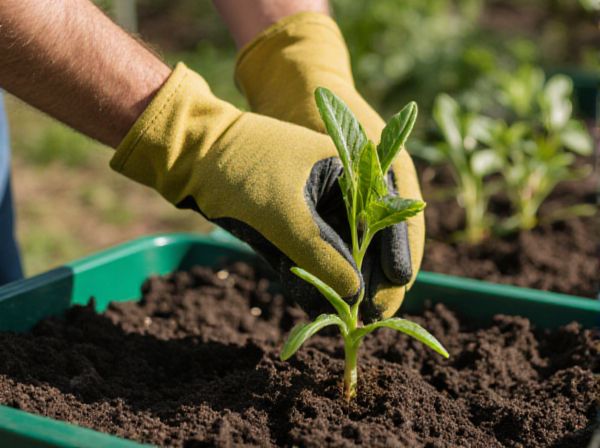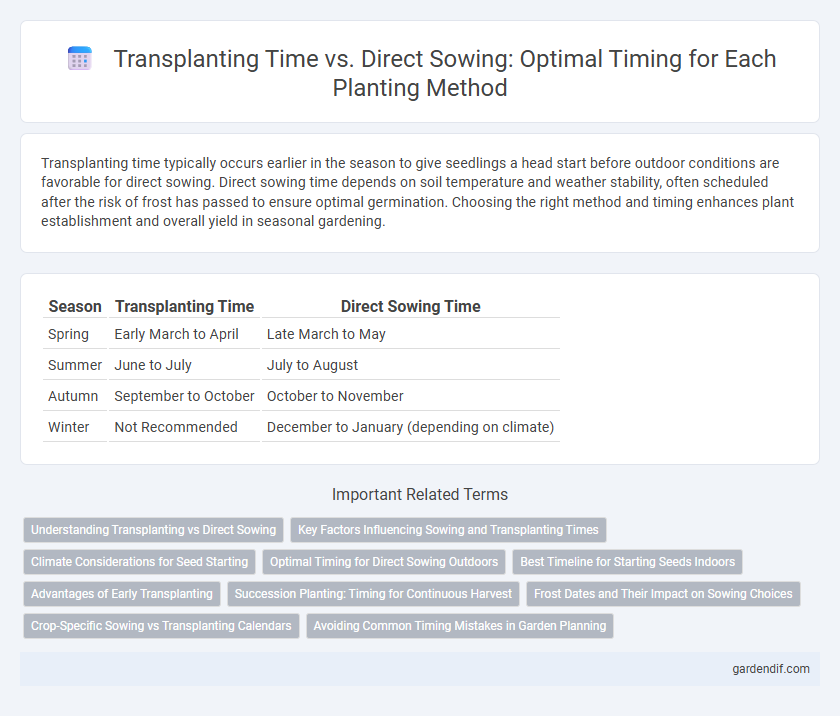
Transplanting time vs Direct sowing time Illustration
Transplanting time typically occurs earlier in the season to give seedlings a head start before outdoor conditions are favorable for direct sowing. Direct sowing time depends on soil temperature and weather stability, often scheduled after the risk of frost has passed to ensure optimal germination. Choosing the right method and timing enhances plant establishment and overall yield in seasonal gardening.
Table of Comparison
| Season | Transplanting Time | Direct Sowing Time |
|---|---|---|
| Spring | Early March to April | Late March to May |
| Summer | June to July | July to August |
| Autumn | September to October | October to November |
| Winter | Not Recommended | December to January (depending on climate) |
Understanding Transplanting vs Direct Sowing
Transplanting involves starting seedlings indoors before moving them outside, offering better control over early growth and extending the growing season. Direct sowing places seeds directly into the soil at the appropriate season, promoting stronger root systems but requiring optimal soil conditions from the start. Selecting between transplanting and direct sowing depends on crop type, climate, and desired harvest timing to maximize yield and plant health.
Key Factors Influencing Sowing and Transplanting Times
Key factors influencing sowing and transplanting times include soil temperature, moisture levels, and crop type, as these determine seed germination and seedling survival rates. Seasonal variations such as frost dates and daylight hours critically affect the optimal timing for direct sowing versus transplanting to ensure healthy plant development. Understanding local climate patterns and crop growth cycles helps optimize the balance between transplant shock and early growth advantages.
Climate Considerations for Seed Starting
Transplanting time and direct sowing time depend heavily on the local climate, particularly temperature stability and frost dates. Transplanting is ideal when seedlings can establish before extreme weather, often after the last frost, while direct sowing suits crops tolerant to cooler soil temperatures for early growth. Understanding climate patterns ensures optimal seed germination and healthy plant development by aligning planting methods with seasonal temperature fluctuations.
Optimal Timing for Direct Sowing Outdoors
Optimal timing for direct sowing outdoors varies by plant species but generally aligns with soil temperatures reaching 50-70degF, ensuring seed germination and early growth are supported. Transplanting time often follows earlier indoor sowing approximately 4-6 weeks before the last frost date, allowing seedlings to establish before being moved outdoors. Direct sowing in spring after the danger of frost maximizes growth potential and reduces transplant shock for crops like beans, carrots, and peas.
Best Timeline for Starting Seeds Indoors
The best timeline for starting seeds indoors typically ranges from 6 to 8 weeks before the last expected frost date, allowing seedlings to develop sufficiently before transplanting outdoors. Transplanting time is crucial because moving seedlings too early can expose them to cold stress, while direct sowing is ideal for heat-loving plants that do not transplant well. Understanding the specific frost dates and seedling growth requirements ensures optimal plant establishment and maximizes crop yield.
Advantages of Early Transplanting
Early transplanting allows seedlings to establish stronger root systems before facing harsher weather conditions, resulting in improved plant vigor and higher yields. This method shortens the growing season, enabling crops to mature faster compared to direct sowing, which depends heavily on soil temperature and moisture conditions. Early transplanting also reduces weed pressure and pest risks during critical growth stages, promoting healthier and more resilient plants.
Succession Planting: Timing for Continuous Harvest
Succession planting maximizes harvest by staggering transplanting times and direct sowing intervals to ensure continuous crop production. Transplants establish quickly, shortening time to maturity compared to direct sown seeds, which require longer germination and growth periods. Optimizing the timing between these methods allows gardeners to maintain a steady supply of fresh vegetables throughout the growing season.
Frost Dates and Their Impact on Sowing Choices
Frost dates crucially determine whether to transplant or direct sow, as early or late frosts can damage seedlings or seeds sown too soon. Transplanting after the last frost date reduces seedling exposure to cold, ensuring stronger initial growth. Direct sowing aligns with soil warming post-frost, promoting higher germination rates for frost-sensitive crops.
Crop-Specific Sowing vs Transplanting Calendars
Crop-specific sowing and transplanting calendars are essential for optimizing growth cycles and yield. Transplanting times usually occur earlier in the season to give seedlings a controlled start, while direct sowing aligns with optimal soil temperatures for each crop. Tailoring schedules based on species-specific requirements ensures precise timing for planting or transplanting, maximizing crop health and productivity.
Avoiding Common Timing Mistakes in Garden Planning
Transplanting seedlings too early or too late can stunt plant growth or expose young plants to harsh weather conditions, while direct sowing requires precise timing to ensure seeds germinate in optimal soil temperatures. Gardeners should match transplanting schedules with local frost dates and soil warmth, and sow seeds directly only when the soil is consistently warm and moisture levels are adequate. Careful attention to regional climate patterns and plant-specific timelines minimizes the risk of poor emergence, bolting, or seedling loss.
Transplanting time vs Direct sowing time Infographic

 gardendif.com
gardendif.com